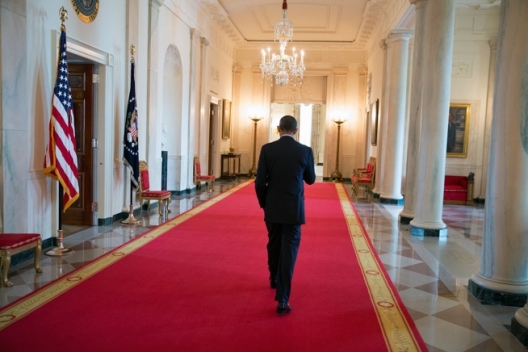 President Obama’s tepid response to Bashar al-Assad’s use of chemical weapons illuminates how he might react to a decision by Iran to build nuclear weapons. In both cases, he has drawn red lines that are extremely costly to enforce.
President Obama’s tepid response to Bashar al-Assad’s use of chemical weapons illuminates how he might react to a decision by Iran to build nuclear weapons. In both cases, he has drawn red lines that are extremely costly to enforce.
For Syria, this red line was the movement or use of chemical weapons, for Iran, the manufacture of a nuclear weapon. The red line for Iran is deliberately blurry, but Director for National Intelligence James Clapper suggested enrichment to ninety percent would trigger action. In Syria’s case, Obama reneged on his threats and may likely do the same if Iran gambles for a nuclear weapon. To be sure, most will stress that denying Iran nuclear weapons outweighs the importance of preventing the further proliferation of chemical weapons into the hands of extremist groups. Nonetheless, waging war with Iran contradicts the president’s broader goals of disentangling the United States from conflicts in the Middle East.
In April, the White House wrote Congress a letter relaying the intelligence community’s assessment that the Syrian regime had used chemical weapons on a small scale. Then, almost two months later, Obama announced a meager plan to arm rebels as punishment. While he claimed the use of chemical weapons would led to “enormous consequences” back in August 2012, his actual policy reaction left leaders of the Syrian opposition despondent. In a letter to Congress, Chairman of the Joint Chiefs of Staff Martin Dempsey outlined the reasons for inaction. Exerting control over chemical weapons would cost well over one billion dollars a month, he said, and require a no-fly zone as well as troop deployments and air and missile strikes. Such actions would obviously represent an act of war, endangering military personnel and compromising US security elsewhere. Dempsey also warned that dismantling the government without sustaining a state-building effort could lead to a countrywide power vacuum. These same costs and risks would apply to strikes on Iranian nuclear facilities at a minimum.
Striking Iran guarantees few benefits and carries many uncertainties. The foremost uncertainty is the targeting ability of the US military; would the United States know what and where all the targets are? In the mid-1990s, Iran sent a group of seventy-seven scientists to study at Italy’s International Center for Theoretical Physics, enabling the country to gain an indigenous mastery of the fuel cycle. The ability of the United States to bomb enrichment plants is unquestioned, but whether it can bomb knowledge is unclear. Furthermore, the destruction of Iran’s nuclear infrastructure will require not just air power but also the deployment of special operations forces and intelligence assets. In terms of negative consequences, an attack would validate the regime’s narrative, unite the country, and perhaps result in a firmer resolution to build nuclear weapons. Another cost concerns the likelihood of Iran closing the Strait of Hormuz and clogging the oil that flows through it. A successful blockade would hold hostage twenty percent of the global supply of oil. Even a ten percent increase in oil prices could shave off .4-.6 percent of US GDP growth.
The option also poses high risks of retaliation. Iran has the capability to conduct terrorist operations against “soft” American targets around the world. Iran or its surrogates could attack businesses, non-governmental organizations, missionaries, and virtually every American establishment in the region and beyond. Iran’s Revolutionary Guards Corps has consistently stated that it will launch missiles at Israeli targets and US interests in the greater Middle East in the event of an attack; that it has contingency plans to strike at US and Israeli interests outside of the region; that Hezbollah would retaliate against Israel; and, that it will consider the United States complicit in an Israeli strike on Iranian soil. How would the United States protect its many citizens abroad if Iran followed through on its threat to stage concerted, continuing asymmetrical attacks against Americans? Launch a fuller scale war against Iran?
Obama most likely imposed a red line on Iran out of political pressure and perhaps without seriously contemplating its consequences. Looking dovish on Iran, as the confirmation hearing for Defense Secretary Chuck Hagel so strongly illustrated, is politically dangerous. According to a recent Pew Research Center poll, sixty-four percent of Americans say it is more important to prevent Iran from developing nuclear weapons than to avoid a military conflict. At least the president has kept his exact red line unknown and therefore has greater flexibility than other politicians would like in deciding when or if to bomb Iran. While refusing to accept Tehran’s nuclear aspirations certainly conforms to public opinion, it does not, by words alone, represent a cogent strategy of deterrence. With the specter of reelection gone, President Obama’s best option for avoiding this collision course set by the public is to inject confidence into talks by dropping the bellicose rhetoric.
Henry Johnson is an intern at the Council on Foreign Relations and former intern at the Atlantic Council. He is a senior at Claremont McKenna College.
Image: President Barack Obama walks through the White House. (photo: White House/Pete Souza)
